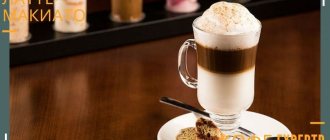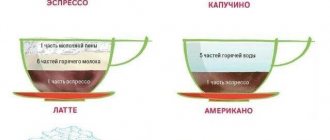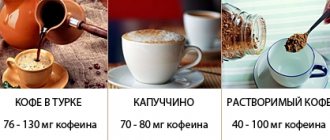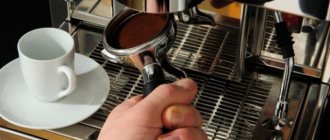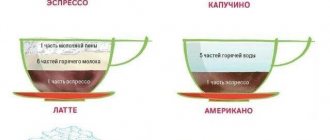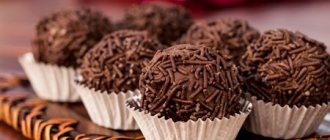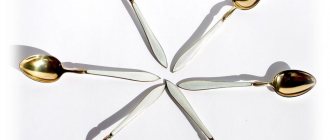History of the macchiato
Coffee macchiato came into fashion in the 1930s. In Italy, espresso just became popular, which was usually drunk at lunch (Italians love cappuccino in the morning). But many coffee shop visitors ordered espresso with milk foam at lunchtime.
However, depending on the proportions and method of mixing the ingredients, you can make a cappuccino or latte from espresso and milk. So that visitors don’t have to explain for a long time exactly how much milk to add to coffee, baristas came up with the name “macchiato” (macchiato means “spotted” in Italian). A white speck of milk foam is clearly visible on the golden espresso foam.
The problem is that latte macchiato, which is prepared completely differently than the classic Italian macchiato, is no less popular. The international coffee chain Starbuks has contributed to the confusion by serving a drink called the “caramel macchiato” since the late 90s. It is a milkshake, similar in preparation to a latte macchiato.
As a result, a good half of the coffee macchiato recipes listed on the Internet are actually latte macchiato recipes. If you want to order a real macchiato, you need to take into account that only in Italy will the barista understand exactly what the client wants. In all other countries, it is better to check by ordering an espresso macchiato. Otherwise, there is a high chance of getting a latte macchiato or caramel macchiato.
What is a macchiato
The word “macchiato” is translated from Italian as “spotted”. Therefore, coffee macchiato refers to a drink that has a characteristic speck on the foam. “Stained” coffee is obtained due to the method of its preparation: hot espresso is added in a thin stream to frothed milk. After this, the foam rises to the top, and a speck forms on its surface.
Latte macchiato was invented by Italians who could not imagine their life without coffee, so that their children could also enjoy the pleasant taste of coffee. Children's attention to this drink was due to its low caffeine content. Gradually, this cocktail became popular not only among children, but also among adults who value the delicate aromatic milk-coffee taste.
The difference between coffee macchiato and coffee milkshakes
Despite the confusion in names, macchiato is easy to distinguish from cappuccino, latte and latte macchiato:
- Macchiato contains less milk than coffee, milkshakes have the same or more;
- Macchiato is prepared by adding milk foam to espresso; to prepare latte macchiato, coffee is poured into frothed milk;
- Not only espresso, but also any other black coffee (brewed in Turkish, French press, pour over) is used as a coffee base for cappuccino, latte and latte macchiato. Macchiato is made only with espresso;
- cappuccino, latte and latte macchiato are served in tall glass glasses or cups, and occasionally in large ceramic cups. Macchiato is served in regular ceramic espresso cups, or, if taken out, in small disposable cups.
Cooking recipes
Traditionally, coffee macchiato is made from 50 ml of frothed milk and 25 ml of strong espresso. The milk is heated to 70 degrees and whipped into thick foam, poured into a cup or glass, and espresso is carefully poured over a spoon in a thin stream so that it is above the milk, but under the foam. The milk temperature should be lower than the espresso temperature.
It is better to froth the milk in a coffee machine using hot steam, so it will turn out to be the correct consistency. If this is not possible, the milk is heated to 70 degrees and whipped in a blender or using a mixer.
Traditional serving of macchiato in a cafe
There are many variations of macchiato with the addition of chocolate, spices, and syrups. To make a latte macchiato, you can use the following recipe:
- prepare 100 ml of milk with 2-3% fat content;
- brew 70 ml espresso;
- pour half of the cold milk into a tall glass, heat the other half and whisk until foamy;
- Pour hot espresso into the cold milk, spoonful at a time, and warm whipped milk on top.
If desired, espresso is brewed with sugar, and chocolate chips are used as decoration.
Caramel coffee macchiato has an original taste; the recipe is as follows:
- brew 80 ml espresso;
- heat 200 ml of milk, add 2 tsp. vanilla syrup and beat with a mixer until foamy;
- Prepare 2 glasses, fill them with whipped milk and pour in espresso by spoon;
- Gently pour 2 tsp on top in thin streams. caramel syrup per glass.
The syrup can be prepared at home. It is stored in the refrigerator and used not only for coffee, but also for various confectionery products. For the syrup, mix 250 ml of water and 200 g of sugar in an enamel bowl, stir, pour in 1.5 ml of vanilla extract, bring to a boil and cook over low heat for 5-8 minutes, cool and store in a glass container.
Thick caramel is added for taste, smell and decoration.
Macchiato can be prepared with cocoa, cinnamon and other not too aggressive herbs or spices. The brewing technology is simple: spices can be added to the coffee pot when brewing espresso or directly into the cup before pouring in the frothed milk. It is recommended to sprinkle cocoa on top of the finished drink for aroma and decoration.
You can prepare a macchiato in a coffee machine in just a couple of minutes. For this purpose, ground coffee capsules are used. BOSCH Tassimo coffee machines produce capsules with coffee and a milk component, so you can now prepare different types of drinks without any problems. To do this, coffee and milk capsules are loaded sequentially. The range of capsules is quite large, so you can choose a drink based on your preferences.
Composition and proportions of coffee macchiato
For a macchiato, it is important that the espresso has a fluffy crema. It is obtained if coffee is prepared from a mixture of Arabica with 10–15% Robusta. There should be no more robusta in the blend, otherwise the coffee will be too bitter. Those who do not like excessive strength and bitterness in the drink should choose mixtures from different varieties of 100% Arabica.
To prepare the coffee base, you need fine espresso coffee or a slightly finer grind. The preferred degree of roasting is medium, milk does not go well with dark roast coffee, this taste is not for everybody.
In order for the taste of coffee to reveal itself as fully as possible, you should brew coffee in bottled water with a mineralization of 75–250 mg/l (optimally 150 mg/l). Tap water contains chlorine, which affects the taste of coffee. Boiling does not help, as the process creates chlorine compounds. To slightly improve the quality of tap water, it is purified using a carbon filter or an ozonizer.
According to experts, milk with a fat content of 2.5–3.2% froths well. Macchiato with baked milk has an original taste. There is no point in adding skim milk to coffee: an extra 1.5–4 calories will not particularly affect your figure, and whipped milk of medium fat content is much tastier. For those watching their figure, it is better to give up sugar, as just 5 g increases the calorie content of a macchiato serving by 19.35 kcal.
Peculiarities
Latte macchiato contains espresso and frothed milk. The taste and calorie content of the drink depends on them. According to the classic recipe, sugar is optional: warm milk already slightly softens the coffee astringency. Additional sweetness is added by grated chocolate, which you can sprinkle on the milk foam.
Ingredient Selection
Milk with a fat content of 2.5-3.2% is suitable for the drink; it has a pleasant taste and whips well into a stable foam. With a low-fat product, the taste will be less pleasant. Full-fat whole milk will overwhelm the coffee notes.
- Read more: What milk to use for cappuccino and other drinks in a coffee machine
To prepare espresso, the basis of the cocktail, you will need a mixture of several varieties of Arabica. Medium (Viennese) roasting of grain is preferable. The grind size depends on the preparation method (for a coffee machine - fine, for a geyser coffee maker - medium, for a Turk - dusty).
Calorie content
The calorie content of a latte macchiato is high compared to espresso, but lower than that of other coffee milkshakes. 100 g of drink contains 55 kilocalories. An average 160 ml serving contains 88 kilocalories. This recipe is perfect for those watching their weight. The energy value increases significantly if you use full-fat milk and add sugar or flavored syrup.
Characteristics of a macchiato
| Bean varieties | 100% Arabica or a mixture of Arabica with 10–15% Robusta |
| Roasting degree | Medium (Full City or Viennese) |
| Grinding | Fine or medium espresso |
| Coffee machine pressure | In the espresso chamber - at least 9 bar, pump operating pressure - at least 15 bar |
| Group water temperature | For medium roast coffee – from +91 to +93 °C, for dark roasted coffee – from +88 to +91 °C |
| Espresso temperature | At the outlet of the holder spout - +88 ± 2 °C, in the cup - +67 ± 3 °C |
| Initial milk temperature | +4 °C |
| Temperature of milk after churning | +60 °C |
| Temperature of the finished drink | +64 ± 3 °C |
| Cooking time | 3–5 minutes |
| Portion output volume, ml | 45–65 (including foam) |
| Caffeine content (strength) | 50–68 mg (per serving) |
| Recommended intake (servings per day) | 1-2 |
| Maximum permissible norm (servings per day) | 7 |
| Calorie content | 7.45–11.1 kcal per serving (depending on milk fat content) |
| Calories with sugar | 26.8–30.45 kcal – a serving of coffee with 5 g of sugar (1 sticker) |
Amaretto
Latte macchiato is a drink that is prepared in different flavors.
One such common option is amaretto.
What ingredients will you need?
- 400 ml low fat milk;
- 150 ml hot espresso;
- 4 tsp. sugar, optional;
- 5 ml Amaretto liqueur;
Step-by-step cooking process
- It is necessary to heat the milk in a saucepan without letting it boil, then thoroughly froth it with a mixer or a special frother.
- Then you need to prepare espresso with sugar and add amaretto to it.
- Next, you need to pour hot milk into 2 tall glasses and slowly pour espresso into them, pouring it over a teaspoon placed on the edge. This will create two decorative layers.
- If desired, you can sprinkle the top milk layer with a small amount of cocoa.
- Serve the latte macchiato immediately.
Features of frothing milk for macchiato
To prepare a macchiato, you need to whip the milk into a homogeneous foam. Pasteurized milk froths best when cooled to +4 °C. You can use either a mechanical or automatic cappuccino maker.
Milk is poured into a metal pitcher. The nozzle of a mechanical cappuccino maker is buried 0.5 cm into the liquid. As whipping proceeds, the jug is lowered: the nozzle should always be at approximately the same distance from the surface. When the foam level is 3–4 cm below the edge of the pitcher, the steam generator is lowered to the bottom.
The pitcher is supported with his palm on the bottom. Whipping is stopped when the milk temperature reaches approximately +60 °C and the metal becomes so hot that it becomes uncomfortable to hold.
To compress the foam, the pitcher with whipped milk is raised 2-3 times 30-40 cm from the table surface and placed on it again. Then, to separate the foam from the milk, make 2-3 rotational movements with the pitcher.
Traditions of serving and drinking espresso macchiato
Classic Macchiato is usually served in traditional ceramic cups. The exception is the caramel version and macchiato with a layered structure.
Although the taste of this coffee is delicate and does not need additional sweetening, a sugar bowl (or stickers) and a spoon (sometimes a straw) are served along with the cup. The foam is decorated with art latte. Or drawings with cinnamon (cocoa), using artistic talent or a stencil.
When adding sugar, the espresso macchiato can be gently stirred with a spoon in a slow circular motion so as not to spoil the foam.
A cup of this coffee is drunk in different ways: in a few sips or after eating the foam.
In Italy, attitudes towards traditions have been elevated to almost a cult. Coffee was no exception. In a country where it is made and drunk at every turn, there are a lot of rules and conventions associated with this drink. Incomprehensible, funny and with deep meaning, they have become one of the colorful features of Italian coffee culture.
Espresso macchiato is closer to desserts, so it goes better with chocolate, fruit and cheese. Meat and fish are not served with it.
Italians traditionally drink macchiato and latte macchiato from the morning until 11 o'clock in the afternoon, between breakfast and lunch. A drink ordered at an inopportune hour confuses Italian connoisseurs of coffee traditions.
It is even customary to apologize to the waiter when making such an order. However, the fair half is “allowed” to drink this coffee at any time. But it’s better not to do this on an empty stomach. Optimally, an hour and a half after eating. In this case, breakfast.
Italians also believe that morning coffee should be drunk while standing, classifying it as a digestif (drinks that improve digestion). There are even bars that charge a premium on the drink consumed at the table.
“Large” doses are not popular on the Apennine Peninsula. Here they prefer to order two servings of coffee.
Classic macchiato recipe
Ingredients:
- 25–30 ml espresso (from 7 g ground beans);
- 10–15 ml of milk at +4 °C;
- cinnamon, grated chocolate, vanilla or caramel syrup - to taste.
Cooking technology
- Whisk the milk until it reaches +60 °C.
- Brew a shot of espresso (pour it into a warm ceramic cup).
- Pour the milk froth into the espresso in a thin stream. Add sugar (vanilla or regular) and caramel syrup to taste. Sprinkle with cinnamon or grated chocolate.
The Italians call a drink with hot milk macchiato caldo. The finished espresso macchiato can be decorated with grated chocolate, cinnamon, apply a few lines of syrup and use a toothpick to turn them into a latte art style drawing.
Many people love macchiato based on doppio - a double shot of espresso. The drink is prepared in the same way as espresso macchiato. The amount of milk, at the request of the guest, is 15–30 ml.
If you are allergic to cow's milk, add coconut, soy, rice or oat milk to your macchiato.
Differences from other drinks
Coffee and milkshakes are often confused. Indeed, they have a lot in common in ingredients and method of preparation. Drinks differ in proportions, appearance and taste.
The recipe for a classic strong espresso macchiato requires only 40 ml of milk per 70 ml of coffee. Latte macchiato has significantly more milk: 100 ml per double shot of espresso (60 ml). Moreover, part of the milk is whipped into foam. The drink has three layers, coffee is in the middle.
In a gentle latte, there are three milk parts for one coffee part. The difference between a latte macchiato and a latte is immediately noticeable if clear glasses are used: a latte has a dark layer at the very bottom of the cup. Latte macchiato occupies an intermediate position between latte and espresso macchiato in terms of the ratio of ingredients, strength and calorie content.
The difference between latte macchiato and cappuccino is in the preparation method and appearance: in cappuccino there is coffee at the bottom and there is a little more of it. Calorie content is approximately the same.
Types of macchiato
Macchiato Fredo
In the summer heat, Italians prefer to drink macchiato fredo - with cold milk:
- Brew a shot of espresso.
- Serve the espresso and separately, in a small ceramic cup with a spout, cold milk (up to 30 ml). The guest himself decides in what proportions to mix the ingredients.
Macchiato Freddo
Ristretto macchiato
Ingredients:
- 2 servings of ristretto with a total volume of 30 ml (from 14 g of ground coffee);
- 10–15 ml milk.
The drink is mixed in the same way as espresso macchiato. Ristretto macchiato has a soft, chocolatey flavor and is less bitter than a regular espresso macchiato.
Ristretto macchiato
Piccolo latte
Although this coffee drink is called a latte, it is closer in taste and preparation method to espresso macchiato.
Ingredients:
- a shot of espresso;
- 25–30 ml milk.
The drink is prepared in the same way as espresso macchiato.
Piccolo latte
Cortado
The baristas never came to a consensus regarding the preparation of cortado. In Mexico, this is what they call espresso macchiato with baked milk. In the USA and some Spanish-speaking countries, cortado is prepared according to the piccolo latte principle: equal parts of espresso and baked milk are mixed.
Cortado is sweeter than a regular macchiato, baked milk gives the drink a more delicate, creamy flavor. If the store does not have baked milk, you can make it yourself.
Sometimes on the Internet there are strange tips to prepare baked milk by mixing regular milk with sour cream and then simmering this liquid in the oven. Most likely, after heat treatment, the milk will curdle, and the result will not be baked milk, but something like mascarpone (to obtain cream cheese, you will only have to strain the liquid). Another “harmful” tip: add sour cream to hot milk and let it sit for several hours. This recipe will make fermented baked milk. Both fermented baked milk and mascarpone are tasty, but they are not added to macchiato.
To prepare baked milk, regular milk with a fat content of 2.5–3.2% is poured into a saucepan or bowl without plastic elements and simmered in the oven over low heat for 30–40 minutes until a puffy brown foam forms. Then turn off the oven and allow the liquid to cool. Baked milk is ready; it does not need the addition of sour cream or cream.
Cortado
Caramel Macchiato
Caramel macchiato is a variation on the theme of latte macchiato, the ingredients form layers, so the drink is served not like a classic macchiato, but in tall glass glasses or cups.
Ingredients:
- 25–30 ml espresso (1 serving);
- 175 ml of milk: 25 cold, for the bottom layer, and 150 for whipping (if desired, add 1 tsp of vanilla sugar);
- 30 ml caramel syrup.
Recipe:
- Whisk 150 ml milk.
- Prepare espresso.
- Pour syrup into the bottom of a heated glass glass or cup.
- Pour 25 ml of cold milk and 150 ml of whipped hot milk on top.
- Pour espresso in a thin stream.
Caramel Macchiato
Special differences between macchiato
Coffee macchiato is a strong espresso with milk, prepared in such a way that the layers of ingredients do not mix, and the container is topped with airy foam. The cooking technology is based on the temperature difference between liquids, due to which they do not mix with each other. To convey the beauty of this drink, it is served in transparent tall glasses.
It is difficult to accurately describe the ratio of milk and strong coffee in a serving of macchiato due to the fact that different countries have their own views on this drink. So, in Italy they prepare a very strong macchiato, consisting of 70 ml of espresso and 15 ml of milk with milk foam. Double espresso with a small portion of milk is often used. Cuisines of other countries prepare a less strong drink, and use both cold and hot milk.
The recipe for “stained coffee,” as macchiato is also called, can include various syrups, spices, and sugar. Its thick foam can serve as the basis for latte art. The main distinguishing feature of the drink is that when preparing, milk is first poured in, and then hot coffee is poured in a thin stream over a spoon. If you do it the other way around, you get a latte.

